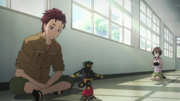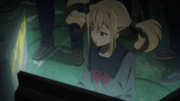Review for Robotics;Notes Part 1
Introduction
The infamous semi-colon has returned, another Nitroplus adaptation of a visual novel, portending the wide range of quality we’ve seen so far from the semi-colon infested anime. We’ve had the sublime to the ridiculous so far, with Chaos;Head leaning to the ridiculous side of things, a forgettable and disappointing sci-fi/otaku show. On the other hand, they took sci-fi with otaku characters again, threw in time-travel, and delivered what might just be one of the best anime in recent years, with Steins;Gate. Incidentally, I’m only devoting 90% of my attention to this review. The other 10% is busy, twiddling his thumbs, waiting for Manga to license the Steins;Gate movie. So when a third visual novel adaptation from Nitroplus arrives for review, once again combining sci-fi with otaku characters, it’s a total shot in the dark as to what the finished result will be like. I doubt that Robotics;Notes will be as bad as Chaos;Head. I don’t think anything can be as bad as Chaos;Head. But I might just be venturing into cloud cuckoo land if I hope that Robotics;Notes will be as good as Steins;Gate. We can always dream though.
It’s the near future, and the world is even more connected than it is now. Your average high school student isn’t too far from his phone-pad, allowing them to interact with the world and each other in innovative ways. But otherwise the schools are much the same as they are now, including the expectation that students join extra-curricular clubs. For Akiho Senomiya, that club is the Robotics Research Club, although she’s practically the sole member. The other member is her best friend Kaito Yashio, but he goes along solely for moral support. The only way he’ll do anything is if someone can beat him at a fighting videogame, and since he’s number five in the world, he can mostly be found lazing while Akiho labours at her dreams. Her big dream is to finish what her sister Misaki started seven years previously, and actually build a working replica giant robot, not just one of the small hobby robots that are in vogue. For that, she’ll need a budget, sponsorship, the school’s support.
But there’s something not quite right in this future world, not least the red aurora that shimmers over Japan every night, or the fact that nine years previously, both Aki and Kai were victims of a strange mass fainting incident on a ferry, which had lasting effects on them both. As Aki goes full throttle trying to recruit new members to the club and realise her dreams, Kai stumbles onto a massive conspiracy.
The first eleven episodes of Robotics;Notes are presented across two Blu-ray discs from Manga Entertainment.
Disc 1
1. Because GUNVARREL is Waiting
2. Because of Dreams, Hopes, and Passion
3. Tanegashi Accel Impaaaact!
4. Let’s Build a Giant Robot of Justice Together
5. May I Call You Brother?
6. It’d Be Sad to Have a Dream End
7. Thank You Berry Much
8. I’m Nae Tennoji! Nice to Meet You!
Disc 2
9. Because It’s the Product of Blood, Sweat, and Tears
10. A Robot that Only We Can Build
11. The Flag Has Been Cleared
Picture
Robotics;Notes gets a 1.78:1 widescreen transfer at 1080p resolution. It’s a splendid transfer bringing across the animation with detail and vibrant colours. It’s clear and sharp throughout, with only the minimal of digital banding that I’ve come to associate with Funimation Blu-rays. It’s certainly not as affected by banding as much as its predecessor Steins;Gate was. The character designs are appealing if not particularly memorable, following the usual high school character design stereotypes. The world design is very detailed and effective with just a hint of near-future high tech to the story to give it that sci-fi edge. The animation itself is top notch, energetic and fluid, while it has an atmosphere and ambience to it that is useful in enhancing the drama. This is a show that is very much meant for the HD format.
The images in this review are sourced from the PR and aren’t necessarily representative of the final retail release.
Sound
Robotics;Notes gives you the usual Funimation options of Dolby TrueHD 5.1 Surround English, and 2.0 Stereo Japanese, with player locked translated subtitles for the Japanese audio, and locked signs for the English. Just like Steins;Gate, there’s more than a few text translations to read, and a quick finger on the pause button will be handy. There’s a slight problem with missing subtitles, one caption at 1.50:33 and one at 2.54:38 on disc 1, but you can get the gist of what is said on both occasions. I went with, and was happy with the Japanese audio, the dialogue was clear throughout, the stereo gave the action some space, and the music drove the story well. I gave the dub a try, and it’s a strong effort from Funimation, a thoughtfully written script (except maybe the l33t-speak for one character), but as usual hampered by teenaged characters that sound in their thirties.
Extras
The discs get animated menus, and on my Panasonic player, an unfeasibly long pause between selecting Play and the player beginning playback, and even the pauses between episodes are lengthy. These look to be the US Blu-rays, localised for Region B by Madman by stripping out the Funimation trailers.
Disc 1’s sole extra is the audio commentary on episode 6, featuring Monica Rial (Junna), and Leah Clark (Furugori). In my new game of seeing how long I can bear listening to one of these things, this one lasted just five minutes. Too much Monica!
Disc 2 offers the ‘textless’ credits with locked subs. You also get the US trailer.
More substantial is the Science Adventure Series Interview Part 1, which lasts 18:47 and is presented in HD. In it, ADR director Joel McDonald, J. Michael Tatum (voice of Okabe Rintaro from Steins;Gate), and head writer at Funimation John Burgmeier get together to talk about the semi-colon series, Chaos;Head, Steins;Gate, and Robotics;Notes, with a little too much emphasis on Steins;Gate for a Robotics;Notes extra.
Finally there is the audio commentary on episode 10, which features Lindsay Seidel (Akiho), and Jarrod Greene (Subaru). They apparently met for the first time on this commentary, and it’s no surprise that it’s gappy and slightly awkward, on top of being the usual Funimation pointlessness. I made it through 13 minutes of this one.
Conclusion
Lightning doesn’t strike twice. Robotics;Notes is certainly no Steins;Gate, although it is enjoyable enough in its own right. It’s just that once you have seen Steins;Gate, and then watch this show, the niggling feeling is always there that this show really wants to be Steins;Gate, wants to match that level of characterisation, and be just as engaging when it comes to its story. Of course it can’t. Steins;Gate was a spectacular piece of work that blended sci-fi, character and narrative in a way that broke out of its genre. What made it special was the sheer quality of the writing, the story unfolded in a naturalistic and plausible way. All of these semi-colon shows have central characters pursuing their own sci-fi interests, and uncovering earth-shattering conspiracies as a result. With Steins;Gate, it was immediately apparent how the conspiracies tied into Okabe Rintaro’s own obsessions. You don’t get that with Robotics;Notes.
It’s a wholly more conventional show, set like so many anime in high school, following a group of students in their extra-curricular pursuits. Here the club is the Robotics Research Club, the passion is for robots large and small, and it’s all about the fun that five friends have together. As for the earth-shattering conspiracy, it has nothing to do with robots, at least at first, and one of the students really just stumbles over it by accident. It’s a far-fetched and outlandish conspiracy at that, one that Kaito Yashio really just pursues as a hobby, half believing it at first, and it’s only towards the end of this collection that things take on a more ominous tone.
The characters are likeable enough, although you don’t have to squint too hard to see that in a couple of cases they’ve tried to ape the Steins;Gate archetypes. Akiho Senomiya, the leader of the club, is the eager go-getter when it comes to her dreams of completing what her older sister started when she began the club, building a full-on giant robot. She’s a fan of the Gunvarrel anime and seeks to recreate that in the real world. And she isn’t averse to pulling a pair of specs out of thin air, striking a pose, and quoting from the anime to motivate her reluctant team. There’s a little Okabe Rintaro about that tendency of hers. Kaito Yashio is in the club simply because he’s that childhood friend of Akiho’s, both have been marked by a traumatic event 9 years previously (a mass fainting on a ferry left Akiho suffering from a metabolic freeze during stressful situations, while Kaito’s reflexes and perceptions get accelerated). Kaito’s more of a slacker, would much rather play a video game than do anything else, but ironically it’s his skills at a fighting game that make him useful for the Robotics Club.
Those skills are first displayed against the next prospective member of the club, Subaru Hidaka, the son of a fisherman who secretly likes robots against his father’s wishes, so much so that he has to compete in robotics tournaments (Think Robot Wars) wearing a disguise. That reveals something of a split personality, shy and awkward as himself, but a quintessential grandstanding anime character when he dons his Mr Pleiades garb. He winds up helping the Robotics Club despite his shyness. Then there is Junna Daitoku, cute and shy enough to qualify for trainee Mayuri of the show, a member of the karate club who gets drafted into the robotics club, not least because her grandfather runs the island’s robotics shop. Alas she and her grandfather are estranged somewhat, which doesn’t help Akiho in getting cheap parts. We’ll have to wait until Part 2 to see just why they are estranged. Finally there is Frau Koujiro, a young otaku, shut-in girl who actually programmed the game that Kaito loves to play, and who comes to the island because she suspects him of cheating at it. She’s socially inept, into boys love manga, and indeed has the same halting, l33t-speak speech-patterns as Steins;Gate’s Daru. Also, in one of those random encounters which turn out not to be, Kaito meets an AI avatar in the form of a little girl named Airi, playful and cute, who helps him on his search for the conspiracy. She has a no-nonsense info-mode as well named Gezi, who has a dry sense of humour.
You have two stories running concurrently. You have Akiho’s need to finish what her brilliant older sister Misaki started, by completing the robot. The robot storyline is a bright, and light, comedic affair, Subaru’s fractious relationship with his father notwithstanding. We follow Akiho as she goes about recruiting to her club, proving to the headmistress that it deserves to survive and be funded, and begging, stealing, and borrowing whatever it takes to get her dream robot, the GunBuild-1 completed. It looks even more promising when JAXA, the Japanese space agency gets involved, re-introducing a Steins;Gate character into the process (although it doesn’t hurt that Akiho’s dad works for JAXA).
Then on the other hand we have the earth-shattering conspiracy, which Kaito investigates on the sly. And all isn’t quite right in this world of 2019, with a bright red aurora hanging over Japanese skies every night, the fainting incident ten years previously, and various other strange occurrences. As well as discovering the AI Airi, Kaito learns of the Kimijima reports, hidden on the island, accessible through completing various flags, and successively unveiling more of the conspiracy, although it looks to be some sort of daft orienteering game at first. But gradually, disparate elements of the conspiracy begin to fall together, such as why the final episode of Gunvarrel was never aired, what happened to Kou Kimijima, just what Frau Kojiro’s mother had to do with it. What role Exoskeleton, the company Akiho’s sister Misaki works for has. The more that Kaito learns, the more serious it looks. Then a magnetic jellybean falls from the sky...
If there’s one thing that Robotics;Notes has, it’s a very bright, and believable near future world, one of even more interconnectedness and even more processing power, but not overdoing it with flying cars and the like. The small hobby robots that the group play with are a little more hyper than the toy robots that we can get now, while when the giant GunBuild-1 is revealed, it’s realistically underwhelming. It’s the real-time communications with the ubiquitous phone-pads that impress, making the world just that bit more interactive. Look at a real-time image of the world on your phone-pad screen, and all sorts of annotations and flags appear. A fun app that Kaito has allows him to overlay an image of cat ears and a tail on Akiho when she gets too serious about her robot. And when he does find Airi, it’s by means of her image appearing on the phone pad but interacting with the real world. Smart phones allow you to do something like this today, but nowhere near as instantaneously or with such clarity. You can imagine them being able to do so in a couple of years though. Another interesting aspect is the Exoskeleton mobility units for paralysis victims, an outgrowth of experimental technology that’s has been demonstrated for real, but in this show it’s been miniaturised, streamlined, and put into mass production, robot legs that are as simple to use as putting on a pair of trousers.
Robotics;Notes is most certainly fun to watch, with likeable characters, an interesting story, and high production values. It’s got a nice sense of humour, blended with a growing level of drama, a lot like Steins;Gate in its first half. But that is half the problem. It’s forcing itself into a Steins;Gate mould, expecting that viewers will want exactly the same structural formula, and its story also seems forced and contrived in comparison to the natural way that Steins;Gate unfolded.











































Your Opinions and Comments
Be the first to post a comment!